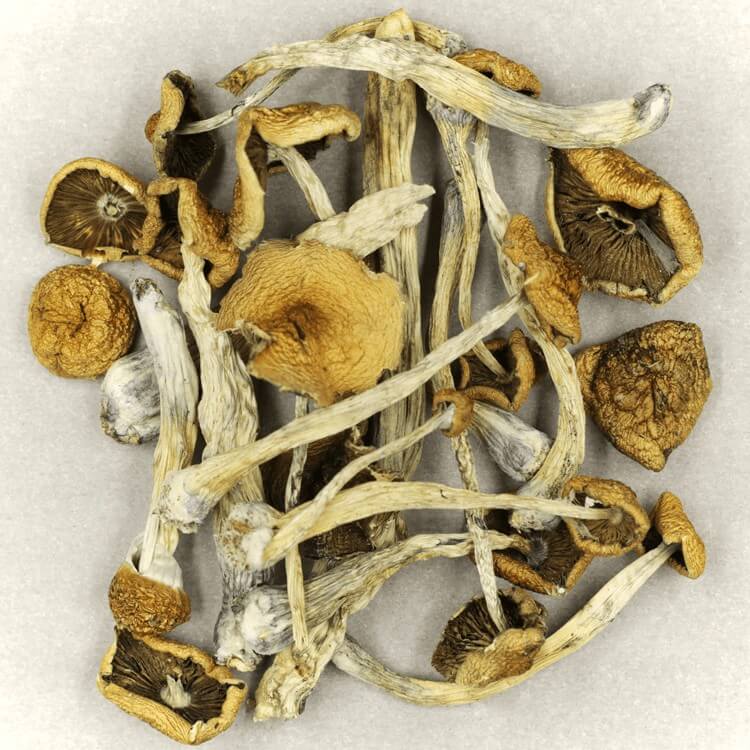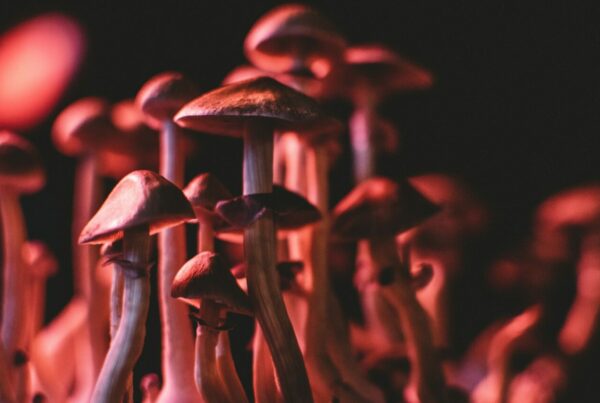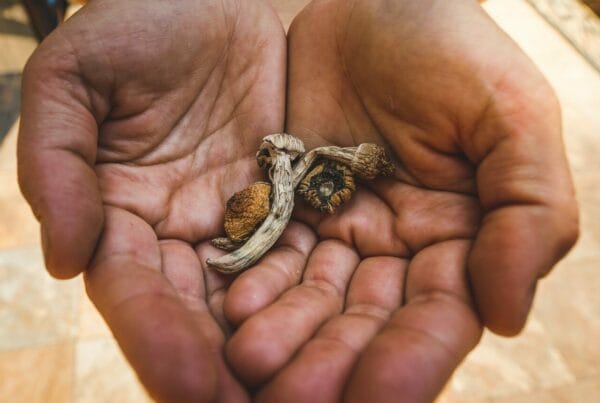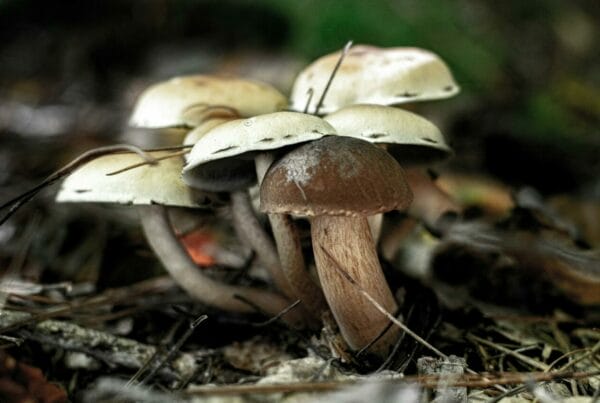Once thought to be mythical, the power of Psilocybe mexicana has been increasingly substantiated through psilocybin research. The scientific community studying psychedelics is consistently uncovering its therapeutic advantages, gradually paving the way for its adoption in the medical field. This burgeoning field is seen as promising by experts, who are continually working to determine safe dosage levels for its medical application.
Key Takeaways
- Researchers are using advanced techniques like liquid chromatography and tandem mass spectrometry to measure mushroom potency.
- Psilocybe Mexicana, along with other mushroom species, is currently being evaluated in clinical trials for its potential therapeutic benefits.
- An accurate dosage chart can be created by understanding the genetic diversity in magic mushrooms.
Psychedelic Mushrooms: A Journey from Mystery to Scientific Discovery
Previously, only a few conditions were thought to gain from Psilocybe Cubensis. However, current research on psilocybin is revealing a vast array of undisclosed medicinal properties.
Researchers are exploring the potential of Psilocybe Mexicana and other powerful strains, using them in clinical trials and extensive study. This strain proves effective in both in vivo and in vitro subjects, providing the most genuine effects and advantages of this fungal species.
Psychedelics Gaining Market Traction
What was once concealed has now been brought to light—ongoing developments and discoveries are increasingly capturing the public’s attention, especially those seeking therapeutic remedies. Traditional mental health treatments often fail to deliver, pushing people to explore more effective alternatives.
Thus enters magic mushrooms.
Individuals afflicted with mental health problems are turning to psilocybin, which has shown potential in treating depression, alcohol addiction, anxiety, compulsions, tics, chronic pain, among others.
Currently, medical practitioners are investigating novel ways to precisely determine the ideal dosage for safe patient administration. Notably, a group of researchers at the University of Texas has developed a model to extract psilocybin and psilocin concentrations.
Establishing the clinical potency of magic mushrooms is indeed possible.
Mexicana’s Distinctive Properties
Golden Teachers, Blue Meanies, and B-Plus are among the magic mushrooms that have been extensively researched. However, for a more comprehensive understanding of the safe usage of magic mushrooms, it’s necessary for researchers to investigate other species as well.
The Mexicana species has emerged as a preferred subject for research. Its status as one of the oldest species coupled with its relatively lower potency, which aligns more closely with medicinal drug standards, make it an ideal choice.
Despite the Mexicana strain being less potent than its counterparts, it can still produce effects similar to mainstream strains. As such, with the rise in popularity of microdosing among patients, this strain becomes a compelling option.
It boasts consistent levels of psilocybin and psilocin akin to other strains. The question then arises – why choose this over similar strains? The answer lies in its historical and anthropological significance.
Delving into a Rich Mexicana History
In ancient times, the psilocybe mexicana mushroom naturally thrived in moss. It was highly regarded by indigenous people for its various applications, particularly in relation to mystical or spiritual occurrences.
Shifting focus to Mexicana mushrooms, it’s worth noting that their use dates back over 2000 years. The earliest recorded usage was by the indigenous peoples of North and Central America. The Aztecs, a historical ethnic group, revered these mushrooms as the “food of the Gods,” or “teonanácatl” in their language.
Even without modern terminologies, the Aztecs, if they were present today, would vouch for the Mexicana’s transformative and emotionally potent effects, and its ability to promote mental stability.
Despite various cultivation methods, this mushroom has retained its natural psilocybin concentrations, a testament to its authenticity. This authenticity is a standard that is highly valued by researchers and psychedelic research institutions.
New Directions in Psilocybin Content and Potency Testing
A team of ten researchers from the University of Texas at Arlington, along with other research institutions, has pioneered a new method for testing the potency of psychoactive compounds in mushrooms. This innovative approach blends liquid chromatography and tandem mass spectrometry.
Here are two groundbreaking techniques:
- Liquid chromatography is a technique that separates and analyzes chemical compounds. In the context of magic mushrooms, it’s used to isolate active chemical components. The procedure involves passing a liquid sample through a column filled with a solid substance, known as the stationary phase. The various chemicals in the sample react uniquely with the stationary and mobile phases, resulting in different separation speeds as they traverse the column.
- Spectrometry is a method that examines the interaction between matter and electromagnetic radiation at different wavelengths. It identifies and quantifies substances based on the particular wavelengths of light that the molecules absorb and disperse, which facilitates the determination of the molecule’s electronic, vibrational, and rotational states.
This approach was employed on five varieties of magic mushrooms. The researchers found that the average total concentrations of psilocybin and psilocin across these strains ranged from 0.879 to 1.36, exceeding other strains like Bull Run and Cambodian. To verify the precision of their study, they compared their findings with data from other independent laboratories.
The alignment between the results from both laboratories further affirmed the reliability of their testing process in accurately ascertaining the potency of the mushrooms.
If these findings are confirmed by experts, they could offer a novel set of techniques to existing methods of assessing psychedelic strength, providing an extra safety layer to prevent inaccurate dosage estimations.
Extending Research to Other Species
Widening the scope of research to include other species can be beneficial. It can deepen our knowledge of the health advantages linked to different strains and provide essential data on the effects of less potent mushrooms.
Moreover, it can help educate individuals about the impact of various dosages on the psychedelic experience. By comparing the Mexican variety with more potent strains like Psilocybe Cubensis, researchers can understand how differing concentrations of active compounds can affect therapeutic results.
For example, the Blue Meanies strain produces stronger hallucinogenic effects, which could potentially be effective for treating conditions such as depression. Conversely, strains with a lower potency may be more suitable for microdosing or for subtler uses like mood enhancement or focus improvement.
Genetic Diversity Leads to Safer Treatments
It’s often overlooked that different cultivars or varieties have distinct genetic profiles and
Different types of hallucinogenic mushrooms vary in potency, chemical composition, and effects. This diversity allows healthcare providers to select the most appropriate kind for specific medical purposes and adjust doses to meet individual requirements. This minimizes risks and maximizes the benefits.
Take for instance, Psilocybe Semilanceata (Liberty Caps) or Psilocybe cyanescens. Their unique alkaloid compositions could potentially be useful in treating anxiety. However, other synthetically grown mushrooms might be better suited for addressing substance abuse or compulsions. This diversity allows for the development of personalized treatments with enhanced safety and efficacy.
From this, we can infer that the genetic diversity among hallucinogenic mushrooms, along with new techniques of potency assessment and identification, plays a vital role in creating safer medical treatments.
Enhancing Safety in Medical Use
Let’s discuss the potential benefits of safer dosage practices.
- Decreased risk of overdosing: Accurate dosing eliminates the fear of overdosing, implying the need for clearer product labeling to avoid consumer confusion.
- Improved predictability: With precise dosing, individuals can better anticipate their experiences during the trips, reducing overwhelming sensations and anxiety, and enhancing patient satisfaction.
- Standardized measurements: Accurate dosing helps establish a uniform metric that allows people to refer to charts for potential effects.
Experience the Advantages of Accurately-dosed Shrooms with State-of-the-art Potency Tests | Buy Magic Mushrooms Online from Magic Mushrooms Montreal Canada
If these two breakthrough techniques continue to evolve, you won’t have to deal with unexpected effects. Pair this with smart online shopping at Magic Mushrooms Montreal Canada. We offer dried mushrooms that ensure a calm, soothing psychedelic journey without excessive psychoactivity. Buy psychedelics online in Canada from Magic Mushrooms Montreal Canada.
Frequently Asked Questions
How does the Mexico Psilocybe Mexicana compare to the Big Mexican?
Do Big Mexicans and Psilocybe Cubensis have the same properties?
No, Big Mexicans and Psilocybe Cubensis are distinct mushroom strains and should not be confused. Big Mexicans have a higher level of compound isolation, ranging from 0.5% to 1%, making them notably more potent.
It’s important to note that Psilocybe Mexicana is less potent than Psilocybe Cubensis. You can also distinguish them by their appearances: Psilocybe Mexicana typically has a bell-shaped cap, while Psilocybe Cubensis tends to be conical in shape.
What’s the highest concentration found in Mexican mushrooms?
The concentrations of both psilocybin and psilocin in Mexican mushrooms can reach up to 0.25%. Despite being on the lower end, akin to the Golden Teacher strain, these levels can still induce powerful psychedelic experiences that may have health benefits.
What’s considered a safe dosage for medicinal use?
Typically, a dosage between 1 and 2 grams is recommended. However, this can vary depending on factors such as the method of consumption, individual metabolism, and specific strain potency. Some individuals opt for sub-threshold doses ranging from 0.05 (50mg) to 0.025 grams (250mg) to mitigate the hallucinogenic effects.





